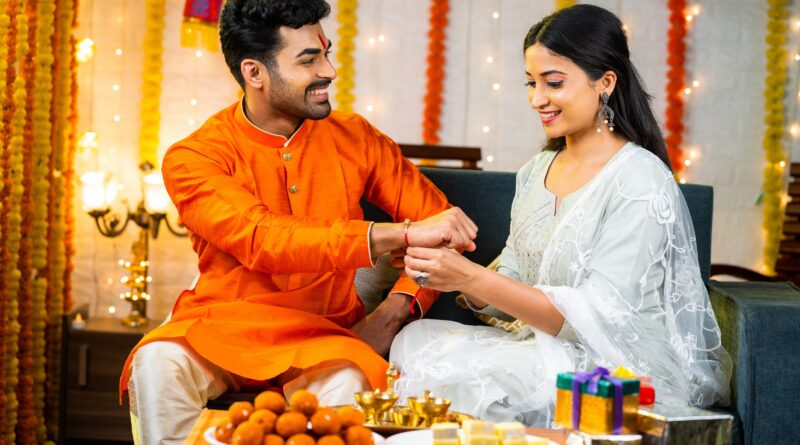Tying the Knot of Love: A Deep Dive into Rakhi Celebrations
Raksha Bandhan, or Rakhi, is more than just a festival; it’s a vibrant tapestry of emotions, rituals, and cherished memories that celebrates the enduring and unique bond between brothers and sisters. At its core, the festival is a powerful affirmation of love, duty, and protection. While the image of a sister tying a decorative thread on her brother’s wrist is iconic, a deeper look reveals a rich history, a web of traditions, and a cultural significance that has evolved over centuries.
This detailed blog post will take a deep dive into the heart of Rakhi celebrations, exploring its origins, the profound meaning of its rituals, and how the festival continues to thrive and adapt in the modern world.
The Origins and Significance: A Bond Beyond Blood
The roots of Raksha Bandhan are intertwined with ancient Indian mythology and historical events, making its story as diverse as the culture itself.
- The Legend of Krishna and Draupadi: One of the most popular tales traces the festival to Lord Krishna and Draupadi, the wife of the Pandavas. During the Mahabharata, Krishna sustained a deep cut on his finger. Seeing him in pain, Draupadi, without a moment’s hesitation, tore a piece of her sari and tied it around his wound to stop the bleeding. Touched by her gesture, Krishna was so moved that he vowed to protect her from all evils. He fulfilled this promise years later during her public humiliation, where he miraculously provided her with an endless sari to protect her modesty. This story beautifully illustrates the essence of Rakhi: a small act of love leading to a lifelong promise of protection.
- Historical Echoes: Historically, Rakhi has been a symbol of peace and camaraderie. It’s said that the Rajput queen, Rani Karnavati, sent a rakhi to the Mughal Emperor Humayun, seeking his protection against an invasion. Humayun, honoring the sacred bond, immediately set out with his army to defend her. This event highlights how the rakhi transcends religious and social barriers, fostering a sense of universal brotherhood.
- The Modern-Day Meaning: Today, Rakhi has evolved to celebrate all forms of platonic bonds. Sisters tie rakhis to each other, and friends and cousins use the occasion to reaffirm their close relationships. The central theme, however, remains constant: a promise of unwavering love and support.
The Sacred Ritual: A Step-by-Step Guide
The ceremony itself is a series of simple yet deeply meaningful rituals that are performed with great reverence.
- The Puja Thali Preparation: The ceremony begins with the sister preparing a puja thali (a ceremonial plate). This thali is a miniature universe of symbolic items:
- Rakhis: The beautiful threads, often adorned with beads, stones, or symbols of good luck.
- Kumkum and Chawal: Used to apply the auspicious tilak on the brother’s forehead. Kumkum symbolizes good fortune, while chawal represents prosperity.
- A Lighted Diya (Oil Lamp): The flame of the diya represents the divine light and is used to perform aarti, a ritual that wards off evil and brings positive energy.
- Sweets: A variety of sweets, from traditional mithai to modern chocolates, are included to symbolize the sweetness of their relationship.
- The Ceremony: On the day of Rakhi, the sister and brother sit together, often dressed in new clothes. Many siblings love to plan their Raksha Bandhan Outfit Ideas to match, choosing vibrant traditional attire like kurtas, sarees, or lehengas to capture the festive spirit. The sister begins by performing an aarti for her brother, circling the thali around his face. She then applies the tilak on his forehead, a sign of her blessings.
- Tying the Rakhi: This is the pinnacle of the ceremony. The sister ties the rakhi thread around her brother’s right wrist. As she does so, she recites a prayer for his long and prosperous life. The brother, in turn, offers his blessings and reiterates his lifelong promise of protection.
- The Exchange of Sweets and Gifts: After the rakhi is tied, the sister feeds her brother a piece of sweet, and he does the same for her. This is followed by the brother presenting his sister with a gift. The gift, whether a simple token or a grand surprise, is a symbol of his love and a tangible representation of his vow. In recent years, the trend of sisters also giving gifts to their brothers has become common, turning it into a mutual exchange of affection.
The Modern Evolution: Celebrating from Afar
In today’s globalized world, where siblings often live in different cities or even continents, the festival has adapted beautifully without losing its essence.
- E-Rakhis and Virtual Celebrations: The digital age has given rise to E-Rakhis and virtual celebrations. Sisters courier rakhis and gifts to their brothers in advance and then connect via video call to perform the rituals together, bridging the geographical distance with technology.
- Rakhi for All: The festival’s spirit has expanded beyond blood relations. People tie rakhis to cousins, friends, and even to soldiers protecting the nation, highlighting the festival’s message of universal love and protection. The tradition of Lumba Rakhi, where a sister ties a rakhi to her brother’s wife (bhabhi), also celebrates her as an integral part of the family.
- The Focus on Thoughtful Gifting: While gifts have always been a part of the festival, there’s a growing emphasis on thoughtful and personalized presents. Instead of generic items, siblings now opt for gifts that align with their loved one’s hobbies, passions, or needs, making the exchange more meaningful.
The Enduring Charm
The beauty of Raksha Bandhan lies in its ability to be both traditional and modern, personal and universal. It’s a day for siblings to set aside their differences and reaffirm the special bond they share. The rituals, from the puja thali to the tying of the knot, are not just empty gestures; they are powerful affirmations of a relationship built on a foundation of love, respect, and mutual support.
As the festive season approaches, the air fills with the joyful anticipation of reunions, the scent of sweets, and the promise of a day dedicated to this cherished relationship. Rakhi serves as a beautiful reminder that no matter where life takes us, the knot of love that binds us to our siblings is one that can never truly be untied. It’s a celebration of a bond that is truly for a lifetime.




